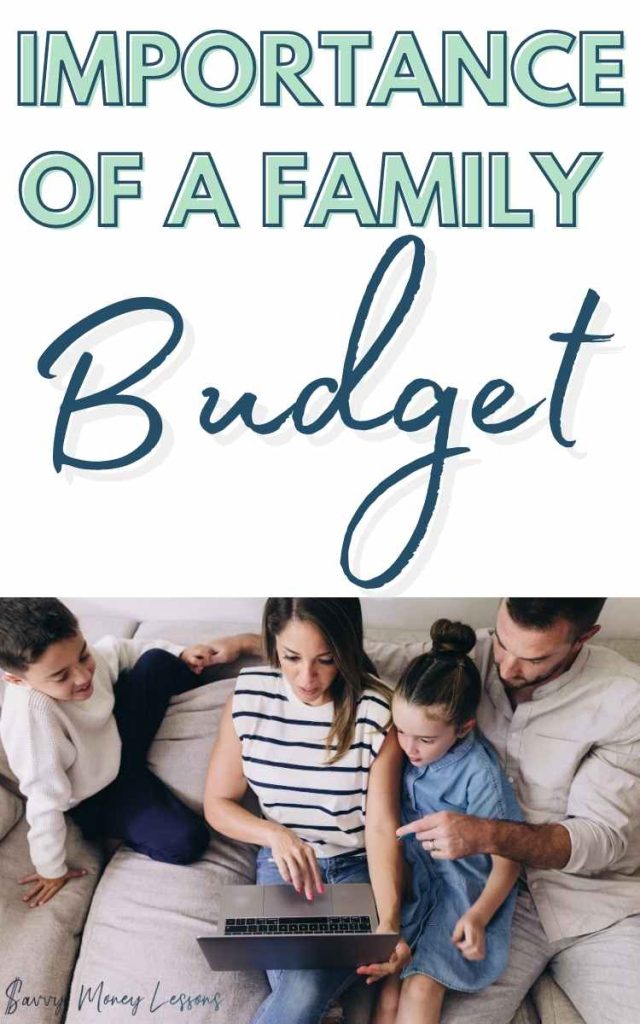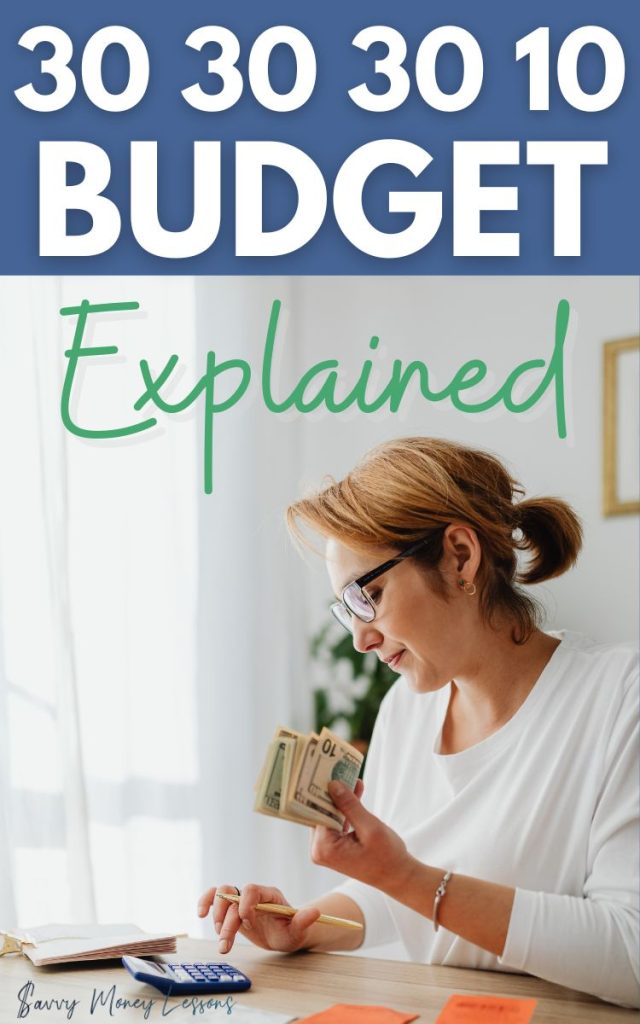Importance of a Family Budget and How to Make One [2023]
This post may contain affiliate links, which means I may earn a small commission if you click and make a purchase. You can read our full disclosure policy here.
Last Updated on July 1, 2023 by Rebecca
The importance of a family budget can’t be underestimated when it comes to managing household finances.
Having a family budget in place means you’re in control of your money, versus letting your money control you. A well-planned monthly budget can ensure that your family’s basic needs are met and that you’re also able to work toward your short and long-term goals.
If you’ve never created a family budget before, or you have but you struggle with sticking to a spending plan, it’s easy to feel overwhelmed. But once you understand the importance of a family budget (and how to create an effective budget) you’ll be one step closer to financial freedom.
Today, we’ve got a simple guide to making a household budget, along with some helpful tips to control your spending habits.

Want free money?
Check out my favorite apps for making extra money and earning cash back!
Survey Junkie. Earn up to $50 per survey for sharing your opinions
Swagbucks. Make money playing games and watching videos ($5 bonus!)
InboxDollars. Take surveys and get paid for your opinions
Rakuten. Earn up to 40% cash back, plus get $30 for each person you refer
CashApp. Get $5 free when you use code ‘VZXRXZN’ to join CashApp
Writers Work. Earn extra cash from your writing skills!
Table of Contents
What Is the Importance of a Family Budget?
A realistic budget is essential for making the most of your family income. Creating a budget makes it easier to manage regular monthly expenses while funding savings goals or paying down high-interest debt.
Approximately two-thirds of Americans live paycheck to paycheck. There are different reasons for that, including high inflation and economic uncertainty.
Those are things you can’t do much about. But making a family budget can be a good way to control what you can when it comes to your finances.
1. Get control of your spending habits
Overspending can throw a wrench in your financial planning efforts. If you don’t know how much money you (or your family members) spend each month, then it’s much harder to achieve a sense of financial security.
Logging into your bank account might have you holding your breath to see how much money you have to buy groceries or cover essential bills.
A good budget can give you perspective into where your money is going and curb unnecessary spending so that you have something left over at the end of the month.
2. Create a savings plan

Saving money is an important personal finance goal.
When you have savings in an emergency fund, for example, then paying for unexpected expenses isn’t a source of stress. If you don’t have cash set aside for rainy days, then you might need to rely on credit cards or loans to cover surprise expenses.
Most financial experts recommend having three to six months’ worth of expenses saved for emergencies. However, only 43% of Americans say they could pay for a $1,000 emergency in cash so if you don’t have an emergency fund in place, you’re not alone.
The good news is that making a budget can help you set some realistic goals for saving and work toward them at a pace that works for your family’s financial situation.
You can use a budget rule like the 70 20 10 budget method, that has you save 20% of your take-home pay. Or you might try a 50 20 30 budget or 80/20 budget instead.
Grow your money faster! Want to get a great rate on your savings? Open a high-yield savings account to earn the most competitive APY on deposits.
Related post: 100 Envelope Challenge Chart [Free Printable Savings Tracker!]
3. Achieve your financial goals
There are lots of things you might want to do with your money as a family that a budget can help with.
Want to take a family vacation? Creating a spending and savings plan can help you reach that goal.
Need to step up your debt repayment efforts so that you can devote more money to saving for retirement? Making a budget can be the first step toward that goal.
Ready to buy a new car? Reviewing your budget can tell you what you’re able to afford.
That’s the importance of budgeting in a nutshell. A realistic budget can ensure that you have enough money to cover the bills while leaving you with extra money that you can apply toward your goals as a family.
Related post: 30 30 30 10 Budget Rule: A Simple Way to Spend and Save
4. Reduce money arguments
You’ve likely heard that arguments about money are one of the top predictors of divorce. As a single parent, I can tell you that money was a major source of friction in my marriage, though it wasn’t the only thing that lead to the end of the relationship.
If you and your spouse or partner find yourselves arguing over money, making a budget can help you to get on the same page financially.
When you’re in agreement about monthly spending and your goals for the short or long term, you end up having conversations about money instead of arguments. Engaging in thoughtful conversations can help you create a shared action plan for managing your family finances.

How to Make a Family Budget
So far, we’ve discussed the importance of a family budget. Now it’s time to make your family budget.
Here’s how to get started, step by step.
1. Outline your family’s financial goals
Before you dig into the actual numbers of putting together a family budget, it’s a good idea to first think about what you want your budget to do for you. That’s where it helps to know what your goals are.
For example, your family financial goals list might include:
- Putting $10,000 into a savings account to cover emergency expenses
- Paying down $15,000 in credit card debt
- Wiping out the last of your student loans
- Saving $5,000 for a family vacation
- Setting aside $12,000 to buy a new-to-you car
- Paying off an extra $5,000 per year on your home loan
- Starting your own business (or encouraging your kids to find ways to make money)
Those are all fairly big goals, but you might have some small ones as well.
For example, if inflation has you feeling frustrated about how much you’re spending at the grocery store, you might set a smaller goal of trimming $100 a month off your grocery bill.
That might seem like a small amount of money to try to save but it adds up to $1,200 extra per year that you could use to fund your other financial goals.
Again, the importance of a family budget for you can depend on your family’s unique needs.
Pro tip: Struggling to stay on top of expenses? Consider using a personal finance tool like Empower to track all of your financial accounts in one place.
2. Add up your monthly income
There are several important steps to making a family budget and knowing how much money you have to work with is at the top of the list.
Sit down with your spouse or partner (and if you’re a single parent, you can do this with your kids) and list out all of the income you have each month. That can include income from:
- Full-time jobs
- Part-time jobs
- Side hustles or odd jobs
- A small business you own
- Child support or alimony
- Government benefits (such as Social Security disability payments or Temporary Assistance for Needy Families)
- Investments (such as interest or dividends)
No amount of money is too small to count if it comes in on a monthly basis.
Will two-parent families always have an advantage when it comes to income? Not necessarily, if only one parent has a consistent income.
The size of the family and where you live can also determine how far that income goes. For example, families living in rural areas might be able to live on a lower income than a family living in New York or Los Angeles.
The most important thing here is to know what the number is you have to work with, not to compare yourself to someone else. Remember that when it comes to family types and finances, everyone is different.
3. Review your monthly expenses
The next step of making a family budget is knowing what your various expenses are and what they add up to each month.
The simplest way to figure out what you’re spending your money on is to review your bank statements and credit card statements for a specific time period.
It’s a good idea to look at least one month’s worth of spending, though you might want to go back three to six months if you have any irregular expenses you sometimes pay.
When looking at your expenses, it’s helpful to break them down into different categories.
For example, you can start with three broad budget categories:
- Fixed expenses. These are expenses that stay the same month to month. So your mortgage payment or child care might go in this category if the amount never changes.
- Variable expenses. Variable expenses are expenses you have to pay each month but the amount isn’t always the same. Phone bills, utility bills, medical expenses and groceries might go here.
- Discretionary expenses. The discretionary budget category includes everything you spend money on that isn’t an essential expense. For example, that might include school supplies, entertainment or new clothes if you have young children who constantly outgrow things.
If you’re making monthly payments to student loans, credit cards or other debts you might put those expenses in a separate category.
Here are some sample budget categories you might use if you’d like to dig a little deeper into the numbers:
- Housing
- Utilities
- Food (groceries)
- Food (dining out)
- Children
- Transportation
- Insurance
- Health care
- Entertainment
- Hobbies and recreation
- Household items
- Giving
- Saving
- Debt Repayment
- Pets
- Personal care
- Miscellaneous
It’s important to account for everything you spend money on here. You’ll need to know what’s coming in and going out to make your new budget and see what kind of cash flow you have to work with.
There’s more than one budget method you can follow to manage family finances. Some of the most popular options include zero-based budgeting, Dave Ramsey budgeting, cash envelope budgeting and the 50/30/20 budget method.
Here’s a closer look at how they work.
Zero-based budgeting
Zero-based budgeting is a relatively simple idea. When making a family budget, you give every single dollar you have a job.
The goal is to have no month left over at the end of the month.
That doesn’t mean you’re spending every penny from your income. You might devote some of your monthly income to saving, investing or debt repayment.
A zero-based budget is designed to give you greater control over your money. By giving every dollar a job, there’s no room to waste money on unnecessary spending.
Dave Ramsey budget percentages
Dave Ramsey is a well-known personal finance guru who created the “baby steps” method for saving and paying off debt.
He also popularized budgeting percentages as a way to break down your spending each month. With this budget method, you divide your income across specific budget categories, assigning a percentage of income to each one.
Here’s what Dave Ramsey budget percentages should look like if you’re following his plan:
- Giving – 10%
- Saving – 10%
- Food – 10-15%
- Utilities – 5-15%
- Housing – 25%
- Transportation – 10%
- Health – 5-10%
- Insurance – 10-25%
- Recreation – 5-10%
- Personal Spending – 5-10%
- Miscellaneous – 5-10%
These percentages are meant to be a rule of thumb and your personal percentages might look different if you decide to use this budget method.
Cash envelope budget method
Envelope budgeting or cash envelope budgeting can be used together with other budget methods to manage your spending.
With cash envelope budgeting, you create envelopes for specific budget categories. You then put the amount of cash you’ve budgeted for the month in each category into its corresponding envelope.
Pro tip: A cash envelope wallet can be a simple way to keep track of your envelopes.
As you spend cash from your envelopes, you subtract it from your starting amount. Once an envelope reaches $0, you can’t spend any more money in that budget category until the new budget period begins.
Cash envelope budgeting can be a great way to get control over discretionary spending.
For example, if you find yourself overspending at the grocery store and buying things that weren’t on your list, paying cash can help you stick to the essentials only. And you can still use banking bill pay services or your debit card to pay utility bills, your mortgage or debt payments.
50/30/20 budget method
The 50 30 20 budget was developed by Senator Elizabeth Warren and her daughter, Amelia Warren Tyagi, in their book “All Your Worth: The Ultimate Lifetime Money Plan”.
This budgeting system advocates breaking up your budget like this:
- 50% for needs
- 30% to wants
- 20% to savings/debt repayment
So, say that your family has a monthly income of $6,000. Following the 50-30-20 budget system, you’d divide it like this:
- $3,000 to cover needs (including housing, utilities, food, etc.)
- $1,800 to cover wants (such as dining out, entertainment, clothes)
- $1,200 for savings and debt repayment
Does the 50/30/20 budget method work?
It could, but it’s not as precise as zero-based budgeting so it’s possible you could end up wasting money. However, you might choose this method for making a family budget if your expenses in the ‘wants’ category vary from month to month. Or you may consider an alternative, like the 10 10 80 budget.
4. Make your budget

We’ve covered the basic steps of creating a family budget. Now it’s time to do it!
Here’s a simple checklist if you’re making a family budget for the first time:
- Add up your income
- Add up your expenses
- Subtract expenses from income
Ideally, you should have money left over once you do the math. You can then decide what to do with the extra money, whether that means saving it, paying down debt or using it for something else.
If you subtract expenses from income and get a negative number, that means you’re spending more than you earn.
In that case, you’ll need to either increase your income or reduce your expenses. Cutting spending is usually easier to do, since you may have some expenses you can cut out immediately.
Using a family budget calculator can help you get an idea of how much you need to cut to get your budget on track. And if you have money left over, you can also use savings calculators to see how fast your money might grow by saving consistently.
Family Budget Worksheet Template
You could use budgeting apps or a Microsoft Excel sheet to track your budget. But if you’re looking for a simple budget worksheet, we’ve got some free ones you can download.
You’ll just need to enter your name and email address to get your family budgeting worksheets delivered to your inbox!

Ready to get your budget together?
Grab our monthly budget worksheet, spending tracker and debt repayment tracker when you join the Savvy Money Lessons email list!
How to Stick to a Family Budget
Making a family budget is one of the best ways to get control over your finances. Any time is a great time to begin making a budget as a family if you haven’t gotten around to it yet.
It’s not enough to make a family budget, however. You also have to be committed to following it.
That’s where getting the whole family on board matters. Even young children can start learning basic concepts like how spending and saving work.
Sitting down together for a weekly or monthly budget check-in can be a good way to review your spending and see where you might be able to improve your budget as a family.
You might also consider talking to a financial advisor about your budget and financial plans if you need some expert guidance. A financial adviser can offer insight into what’s working with your budget and what you might need to change to reach your financial goals.
The Consumer Financial Protection Bureau has some helpful tips on how to choose a financial institution to work with when seeking professional money advice.
Final thoughts on the importance of a family budget
Think about where you are financially right now as a family. Now, ask yourself where you want to be next month, next year, 10 years from now?
Making a family budget can help you to get there. When you have a solid plan for managing your monthly income and expenses, the other parts of the financial puzzle begin to come together in a way that reflects your vision for financial freedom.
Need more money tips? Read these posts next:
- Best Ways to Save Money Every Month
- Cute Budget Worksheets for Kids (6 Free Budget Printables!)
- Important Lessons to Teach Kids About Money
What does the importance of a family budget mean to you?
About the Author
Rebecca is a certified educator in personal finance (CEPF) and a money-saving expert. As a single mom of two teens, she knows all about the importance of family budgeting and financial goal-setting. She shares her best tips about saving and managing money at Savvy Money Lessons. You can also read her work online at Bankrate, Forbes Advisor, Investopedia and other top publications. Learn more

















![100 Envelope Challenge Chart [Free Printable Savings Tracker!]](https://savvymoneylessons.com/wp-content/uploads/2022/04/Savvy-Money-Lessons-Pins-640x1024.jpg)


13 Comments